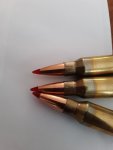I'm sure that I have overlooked something here, but I can't figure it out. Here is my issue:
Loading ADG brass that is new. Ran it through a neck sizing mandrel to be sure necks were round and sized for 2 thou neck tension. Primed, poured powder and started seating Hornady ELD-X bullets. Seating pressure required felt a bit high. Checked neck tension and it was right at 2 thou. 2-3 more rounds loaded and the seating die, a Forster Comp., started sticking. The die chamber was stuck in the compressed position.
Disassembled the whole thing and found the base of the seater stem had belled out and gouged the inside of the die chamber. I polished everything up and reassembled. Tried the whole process again. Same results as first time. Same hard seating pressure, same sticking, same belled out stem. Also noticed the case necks were showing marks from rough die chamber and a slight ring at the base of the neck.
The pic is of the rough necks after loading.
I've never run into this problem in the past and was hoping someone could enlighten me a bit.
Loading ADG brass that is new. Ran it through a neck sizing mandrel to be sure necks were round and sized for 2 thou neck tension. Primed, poured powder and started seating Hornady ELD-X bullets. Seating pressure required felt a bit high. Checked neck tension and it was right at 2 thou. 2-3 more rounds loaded and the seating die, a Forster Comp., started sticking. The die chamber was stuck in the compressed position.
Disassembled the whole thing and found the base of the seater stem had belled out and gouged the inside of the die chamber. I polished everything up and reassembled. Tried the whole process again. Same results as first time. Same hard seating pressure, same sticking, same belled out stem. Also noticed the case necks were showing marks from rough die chamber and a slight ring at the base of the neck.
The pic is of the rough necks after loading.
I've never run into this problem in the past and was hoping someone could enlighten me a bit.



